Harleigh Holmes and the Coleman Motor Company
Not long ago in Littleton's past, the name Harleigh Holmes was instantly recognizable, and his company, the Coleman Motor Company, stood as the most successful business in the area. The great success of the company was due to the inventive genius of Harleigh Holmes, and the efforts of everyone in the company to produce the very best, most reliable products.
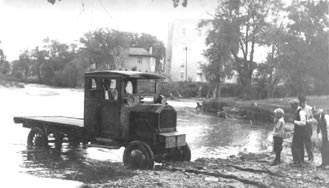
Possibly the first truck made by the Holmes Motor Co., c.1920. Photo looks east from the South Platte River with the Carnegie Library in the background.
Holmes' family had moved to Colorado from Kansas when he was six, in 1886, but soon moved to Ogden, Utah. When Harleigh was in high school, the family moved back to Colorado and he finished his schooling in Denver. He then began working with irrigation equipment in Huerfano County and on the western slope of Colorado. He met and married Katherine Sievers of Carbondale in 1917. They had four children: Dorothy, Harleigh, Lee and Helen Louise. For several years they lived at the corner of Rapp Street and Alamo in Littleton. This had been the location in the pioneer days of an outdoor platform where the local politicians would speak. In 1937 they bought the Richard Little house three doors down the block and restored it, adding extra bedrooms in the attic. The Little-Holmes house had 15 rooms, two baths and a two-car garage.
During the years 1915-1920 Harleigh Holmes, while working in Carbondale, Colorado, had an idea for a new kind of vehicle mechanism-four-wheel drive. Cars and trucks had only been around for about 20 years in 1916. Holmes had the foresight to patent his ideas for a four-wheel drive and a front-wheel drive, and he founded Holmes Motor Company in Littleton to build four-wheel drive trucks.
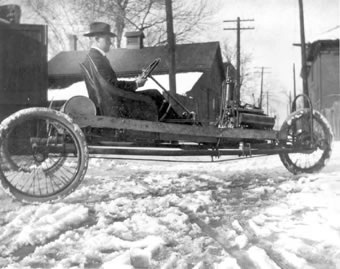
This photo, c.1917, shows the first application of the Holmes drive system. The driver is "Harl" Holmes, designer, who founded Holmes Motor Co. in 1920.
It did not take long before the reputation of the truck began to grow. In April 1921, a heavy snow caused problems for those living in the foothills near Littleton. One man, trapped about three miles into Deer Creek Canyon, was in dire circumstances due to the cold. No one could get to him. Harleigh Holmes heard of the man's plight and decided to help. He and eight of his employees drove a Holmes truck up Deer Creek Canyon, plowing through several four-foot drifts of snow on a vertical incline. They left the road and broke new ground to reach the trapped man, then turned around and brought him out, without any trouble.
Also in 1921, Holmes obtained a loan from Plains Iron Works of Denver. The name of the motor company was changed to Plains Motor Corporation and operations were moved to Denver. The Holmes truck was re-named the Plains four-wheel drive truck. By the summer of 1921, the company had diversified into offering the Holmes system for Fords, converting the Ford trucks into four-wheel drive vehicles. This was a lucrative step for Holmes. Discussions with N.S. Clark of Vancouver, Canada produced an order for 500 Holmes systems and Mr. Clark purchased the Canadian patent rights to the four-wheel drive system. Demonstrations at the Platte River in September, 1921 showed that the Holmes system fitted to a Ford could navigate through deep sand and water hauling a load, while similar vehicles quickly became mired.
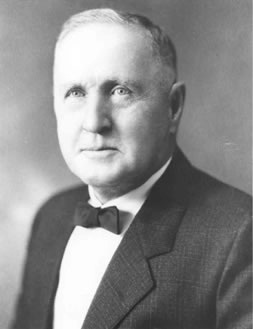
Alfred Coleman, date unknown.
In 1922, wealthy miners Alfred E. Coleman and his brother George bought 51% of the Plains Motor Corporation and Harleigh Holmes moved the plant back to Littleton. The Colemans also bought the creamery building on South Nevada Street in Littleton for the new vehicle operations. Holmes retained a senior position in the new company.
The Coleman brothers from Illinois had struck it rich in the lead-zinc-silver mining district of eastern Oklahoma in the early 1900s. They soon built up a fine cattle ranch, named the C-T, and George financed several businesses in their town of Miami, Oklahoma. George and Alfred remained close, and when Alfred's health began to fail, George arranged the move to Colorado for their families. From 1909 to 1920, Alfred Coleman lived in Rocky Ford, Colorado for his asthma. In 1920, he moved to Denver where he remained.
George Coleman married Jessie Carr, who was 26, in 1911. Alfred married Burnettie Brundage in 1912, but she passed away four years later. Alfred remarried in 1917 to Pearl Silverman. Five years later, Pearl contracted appendicitis and died.
About thirty men were employed in the Coleman plant in the 1920s. Harleigh Holmes utilized an innovative form of marketing the trucks, called Holmes Trucks in 1924. He simply demonstrated how well the trucks worked. Often he would stop to pull someone out of the mud or snow. His employees were instructed to do the same, and the reputation of the trucks became known throughout the area. One anecdote reported by the Littleton Independent (March 14, 1924) told of a Pierce Arrow truck fully loaded with groceries that had become mired in the mud. A Holmes truck returning from Denver loaded with 3 tons of material stopped to help. Without unloading, the driver of the Holmes hooked the two trucks together and the Holmes pulled out the Pierce Arrow "with little effort.
The president of the company, Alfred E. Coleman, found that the reputation of the trucks was enough marketing. However, he did continue a standing wager begun by Holmes:
We will give to the owner of any truck $5000 in cash, providing his truck will equal the performance of the Holmes Truck, and to the owner of any rear-driven truck we will give $5000 in cash providing his truck, with no load, will equal the performance of the Holmes Truck with a load of three tons.
The Littleton Independent wrote several articles about the contests, even including photographs at times. On one occasion, a Holmes truck out-pulled a bulldozer. No truck ever won the bet.
Holmes began touring mining and lumber camps to demonstrate the trucks produced by the Coleman plant, and of course, accepting orders to build new ones. The Littleton Independent (July 18, 1924) noted, "Motor men are frankly stating now, that it will not be long until the Coleman Motor Works will be one of the greatest motor producing plants in the United States.
In March 1925, Calvin Coolidge was re-elected as President of the United States. Traditionally, important and influential people were asked to attend the inauguration in Washington D.C., and on this occasion, Harleigh Holmes and his wife received invitations. They rode by train across the country, and while they were in Washington, Harleigh spoke at the capitol about the possibility of the Coleman trucks being used by the federal government.
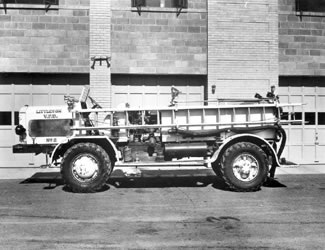
Littleton Fire Department's 1925 pumper, probably one of the first vehicles Coleman Company sold for money. The truck was altered from its original design; the nose was welded in from an old chassis. It was later given to the Street Department which installed a cab and a shovel or crane.
In July of 1925, Coleman completed an order for a fire truck for the Littleton Fire Department. The water from the pump on the fire truck sprayed water eighty feet high, twice as effective as the old fire truck. The Coleman fire truck could attain a speed of 40 mph and could maneuver through two feet of snow or 18 inches of mud. Perhaps most impressive of all, it was able to climb a 50% grade with full equipment and men. The new fire truck was placed on display at the State Fireman's convention in Denver. Public donations helped to finance the truck for the town of Littleton.
The U.S. Army purchased a Coleman truck in April, 1927 for use hauling an anti-aircraft gun for tests. The Littleton Independent boasted that the Washington Post printed an impressive article about the Coleman truck purchase.
George Coleman experienced a difficult time in 1928, when he was blackmailed. While at his Oklahoma estate, he received a letter from someone threatening to blow up Coleman's house unless $4,500 was placed in a certain spot. An irate George refused to pay. A few days later the blackmailer wrote George again, saying he would take George's son if he did not pay. George still refused. A third letter stated he would shoot Coleman if the money was not delivered. George Coleman had run out of patience. He and the police arranged a trap for the blackmailer. A parcel was placed where the blackmailer dictated and the sheriff waited. Finally, two boys approached the area. When they saw the sheriff, they ran but were apprehended later. The older boy received four years in prison and the younger boy was released due to his youth.
Alfred E. Coleman lived in Denver and served as president of the Coleman Motor Company. He was involved in the daily operations of the plant, making the drive from his Denver home to Littleton every day and he was interested in the town of Littleton. In 1928, he became very sick with heart trouble. He died on June 9, 1930. Alfred had no children and left his fortune to his nephew, George Lewis Coleman.
Harleigh Holmes continued to develop new products for the Coleman company. In 1926, a new four-wheel drive truck was added to the inventory. It was half the size of the 5-ton model but otherwise was very similar, even to the famous Holmes hubs on the wheels. Holmes stated he thought the little truck would out-perform the "big job (5-ton truck). On a test at Ruby Hill in Denver, the small truck took a load of 2-1/2 tons up the face of the hill with ease.
In March, 1928, an amazing demonstration took place on Main Street, Littleton — a tug-of-war between a 5-ton Coleman truck and a 10-ton Caterpillar tractor. The Coleman was laden with 12,000 lbs of concrete blocks, while the tractor weighed 20,000 lbs. Even with the weight handicap, and giving the tractor a 15 ft. head start, the Coleman truck won the event. Many influential members of the community cheered on the hometown vehicle. Apart from the outstanding performances achieved in the Coleman trucks, they required little maintenance and rarely broke down.
Colorado's mountain passes suffered from frequent blockages due to snowfalls. An engineer from the state highway department had developed a rotary snowplow, the first of its kind, to clear the snow, but the highway department could not find a truck that could push the plow through the snow on winding roads, until they tried the Coleman truck. A rotary plow with an auxiliary motor was fitted on a 5-ton Coleman in April, 1928 and then driven to Berthoud Pass. The truck and plow cleared a channel through four feet of snow, making 1/2 mile per hour. The Coleman returned a few days later to finish clearing the pass. Another five ton Coleman equipped with a rotary plow opened Berthoud Pass for the summer, 1929.
By 1929, other uses had been found for Coleman trucks. A five-ton Coleman fitted with a Sargent snowplow could easily remove snow from Littleton's streets. In a demonstration, this same Coleman and plow backfilled a long trench dug by Public Service Company twice as fast as a traditional tractor.
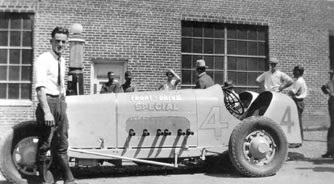
Joe Unser stands next to the car he drove in the Pike's Peak Race, c.1929.
In the late 1920s, George Coleman became interested in racecars and developed a front wheel drive racecar at the Littleton plant. In 1929, the Pikes Peak Hill Climb featured the first three of these cars. They were driven by the three Unser brothers from New Mexico and Colorado Springs: Louis, Jerry and Joe. The next year, two Coleman racecars were entered in the Indianapolis 500. This popular race originated in France in 1894, and was first held at Indianapolis in 1911. Joe Unser and Lou Moore were selected to drive the Coleman cars. While out for a practice drive on US 85 south of Littleton, on February 20, 1930, Joe Unser apparently lost control of his car while passing a slower vehicle and skidded down an embankment. Unser was taken to the hospital and died a few hours later.
Lou Moore of Los Angeles worked with Coleman's engineers to perfect the racecars' design. Phil Shafer drove a Coleman racecar to a seventh place finish at Indianapolis in 1930. Another racecar was entered in the 1931 Indy, but after qualifying at 108 mph, had to be withdrawn because of clutch troubles. That car was equipped with not one but two motors, which provided nearly unmanageable power. For the 1932 Indy, Holmes designed a four-wheel drive car, still with two engines. A Denver man named Merzney was picked to drive it, but the car was wrecked before the race started.
The Coleman Motor Company also began making passenger cars in about 1929. The first of these was affectionately called the "Blue Goose and used front wheel drive. A Model A Ford engine was used, with a transmission set ahead of the axle. The Blue Goose sold for about $1000. An advantage of these cars, said Holmes, was that they could be built lower to the ground than rear wheel drive vehicles without sacrificing headroom or vehicle clearance. The passenger cars had four-wheel brakes. This was one of the first cars with the body as wide as the outside of the tires. The front of the cars had rounded projecting noses and the wheelbase was 108 inches.
The second experimental car called the Maroon Car was built in 1932. It was unique in that the V-8 engine was mounted in the back, but it still had front-wheel drive. Holmes could accomplish amazing things. At the end of 1932, the White Car was built. This was the first of the "arched-axle series in which the front axle was not straight but arched over the engine as in an inverted U." In this case, the engine could be set lower to the ground, thus lowering the center of gravity of the vehicle. The Brown Car had the arched front-wheel drive axle, but had more conventional lines than the White Car. Holmes last car model was called the Custom. It had a slightly smaller body with a larger Ford V-8 engine. The detailing was more intricate, and it was Holmes' favorite. The only problem was keeping the wheels aligned because of the arched axle. Holmes always knew the cars were not meant to make money, but from these models, he patented axles, frames and other engineering features with an eye toward selling them.
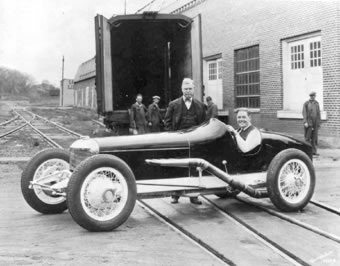
Red Shafer shown driving the Coleman race car that placed 7th in the Indianapolis 500 in 1930.
Coleman Motors worked in partnership with Ford Motor Company to develop a standard Ford truck that had a Coleman front wheel drive and an auxiliary transmission. The U. S. War Department had requested new types of specialized trucks, and in September 1929, just one month before the stock market crash, the first specialized Coleman truck was tested on Ruby Hill in Denver. With an army representative looking on, the truck successfully climbed a steep hill carrying a 3500 lb. load from a standing start. This truck also drove through sand that was "hub deep without effort. The truck was sent to an army camp outside of Baltimore, and others were delivered to the army.
The Coleman Motor Company received an army contract to assemble 720 ten-ton trailers in March, 1944. The trailers were for heavy duty use, able to transport light tanks. They were painted olive, and stood 53 inches high from the ground to the floor and 4 feet from the floor to the top of the sideboards. Many soldiers returning from World War II stopped in at the Coleman plant and related their amazing experiences in the four-wheel drive trucks.
George Coleman passed away on July 7, 1945 and his stock was sold to George Meffley, a Littleton resident living on Bowles Avenue. Operations continued, possibly due to the continuity provided by Harleigh Holmes. Wartime contracts in the 1940s gave them the chance to expand the plant and build new specialized vehicles. One design called for a special truck on which a crane was mounted, to be used by the US Army Corps of Engineers. Several hundred of these were built. The company also marketed kits for converting two-wheel drive trucks into four-wheel drive and even six-wheel drive. The "Coleman Conversion Kit" became quite successful.
In 1948, Coleman Motor Company merged with American Road Equipment Company and a head office in Omaha, Nebraska was established. The name was changed to American- Coleman. Meffley's stock was acquired by the new firm, but Harleigh Holmes still owned a large share of the company. The new board of directors was Howard Agee, William Ramsey and E.L. Martin, all from Omaha, and a Denver attorney, Phillip Van Cise. The Littleton plant continued to build vehicles under the name of Coleman Motors.
This reorganization led to another new product, the aircraft towing tractor. Tests conducted in 1949 at Carswell Air Force Base proved extremely successful and American-Coleman received a contract for 49 tractors. In 1950, another contract for 73 tractors was received, and in 1951, a contract for 495 tractors was awarded. By 1952, American-Coleman employed 460 people and was a household name in Littleton.
On July 26, 1963, Harleigh Holmes passed away. He had been on a ranch tour earlier in the day. He died in his sleep.
More stock buyouts continued over the years, as the Holmes family sold to E.L. Martin and his partner, B.I. Noble. Then, Noble sold his shares to Martin; by 1965, E.L. Martin and his wife held 99% of the stock. Three years later, the Kansas City Southern Industries, Inc. purchased the assets of American-Coleman.
The Littleton plant continued to produce aircraft tractors and axles. In 1981, American-Coleman branched out again, producing the SENTRY Power Dispatch. This was a fuel saving device for diesel electric locomotives.
In 1981, the Holmes family house on Rapp Street was owned by the four children of Harleigh and Kate. The family decided to sell it to a buyer who wanted to use it as office space. The house today stands as one of Littleton's designated landmarks.
A few years later in 1987, the American-Coleman facility in Littleton closed down. Employment had dropped to about 21. Vice President and General Manager Joseph E. McElroy handled the shutdown. The plant building, owned by a local developer, was in foreclosure and was eventually sold. The equipment was moved to Kansas City, the parent company home. A proud history of innovative truck design had come to an end.
Bibliography
Littleton Museum. Vertical File.
Littleton (Colo.) Independent. The Littleton Independent Publishers, 1888-.
Author unknown. "Harleigh Holmes' Homely Honeys, Special Interest Autos, May-June, 1978: p. 32-35.
Author unknown. "Coleman, Colorado's Other Mountain Truck, This Old Truck, date unknown: p. 24-27.
Photographs courtesy of the Littleton Museum unless otherwise noted. To order copies, contact the museum at 303-795-3950.
Compiled by Rebecca Dorward
Edited by Phyllis Larison and Lorena Donohue
Updated April 2021 by Phyllis Larison